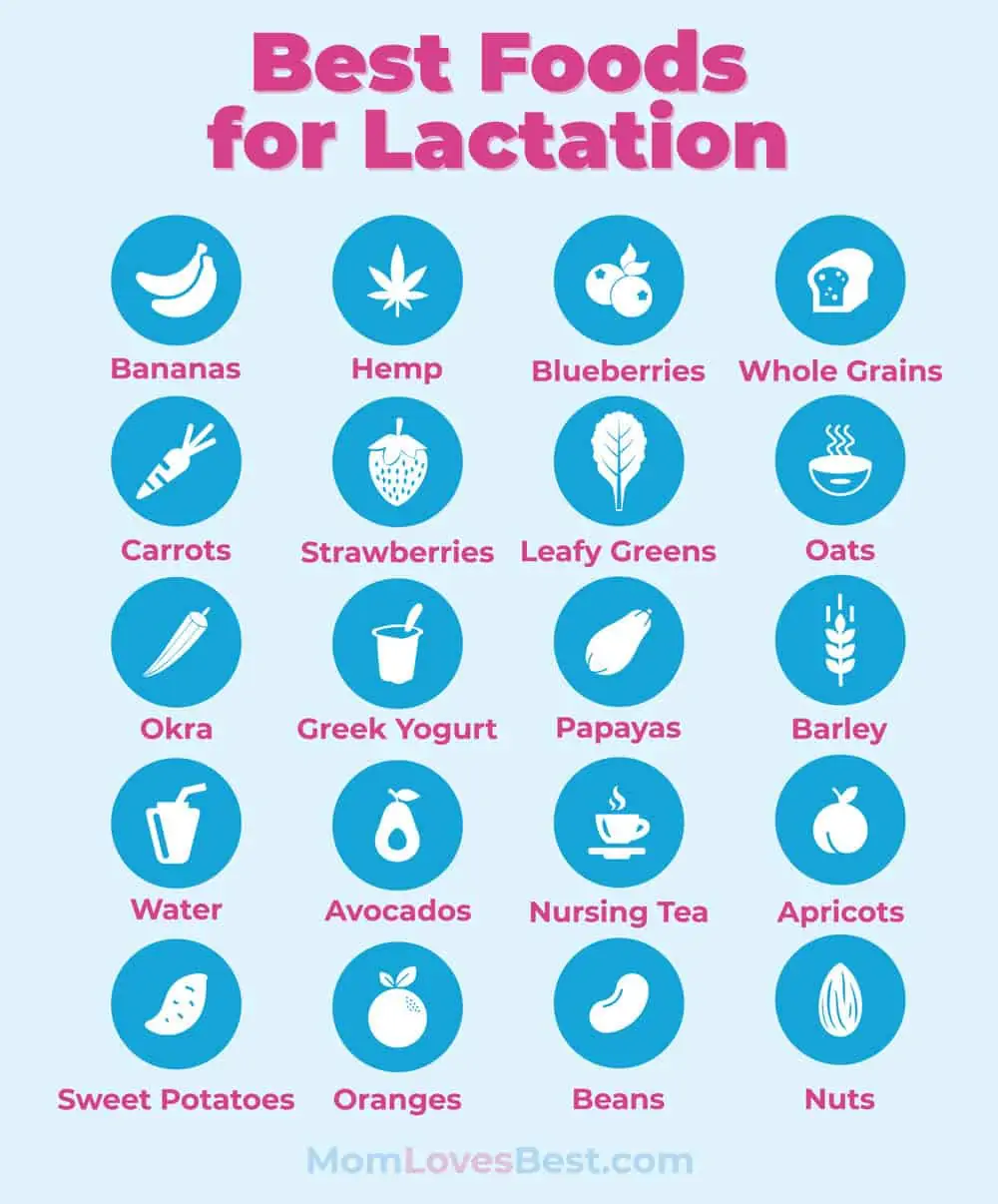Worried you aren’t producing enough milk for your baby? I know that feeling well. It felt overwhelmingly stressful when I had my first bundle of joy.
Breastfeeding is challenging. It is normal to feel stress, self-doubt, and uncertainty while learning to care for a newborn.
There is a lot of information about lactation nutrition out there, and it gets confusing fast. We are here to simplify it. Here is the lowdown on the best foods for lactation to help you feel great and boost your milk supply.
Key Takeaways
- Focus on galactagogues: Incorporate lactogenic foods like oats, barley, brewer’s yeast, and fennel into your daily meals to naturally boost production.
- Prioritize nutrient density: Eat foods rich in healthy fats and proteins, such as salmon, avocados, eggs, nuts, and seeds (chia, flax, hemp).
- Don’t skip veggies and fruits: Dark leafy greens, carrots, green papaya, and berries provide essential vitamins and antioxidants for you and your baby.
- Hydration is key: Drink plenty of water and consider nursing teas or bone broth to maintain hydration levels necessary for milk volume.
Is Your Milk Supply Adequate?
Do your breasts feel heavy when you first wake up? Can you hear your baby swallowing at the breast? Is your baby growing well? These are usually signs your supply is doing just fine.
Your baby’s cheeks should look full when nursing. They should release the breast on their own when finished. You can also judge supply by how “milk drunk” or blissful your baby looks after a feed. Relaxed arms and open hands usually indicate satisfaction.
Diaper output is the most reliable metric. Once feeding is established, a baby should wet eight to 10 diapers per day. The urine should be clear or light yellow.
Weight gain is the ultimate test. Babies lose a little weight right after birth. However, they should gain 4 to 7 ounces per week once my milk comes in and feeding regulates (1).
Common Causes of Low Milk Supply
A low supply of milk happens for various reasons. Here are the most common culprits:
- Poor latching: If your baby struggles to latch deeply, your body won’t get the necessary stimulation to produce more milk. Pain during nursing is often a sign of a shallow latch.
- Infrequent feeding: Milk production relies on supply and demand. If milk isn’t removed, production slows down. Newborns need to feed on demand, typically 8 to 12 times a day (2).
- Anatomical issues: Ties in the baby’s tongue or lip can restrict tongue movement. This prevents effective milk removal. If nursing hurts or the baby clicks while eating, have a pediatrician check for ties.
- Health conditions: Issues like diabetes, anemia, or thyroid imbalances can affect production. Previous breast surgeries or mammary hypoplasia (insufficient glandular tissue) may also limit supply (3).
- Medications and contraceptives: Antihistamines and decongestants can dry up milk. Research also suggests estrogen-based birth control reduces production (4). Opt for progestin-only pills or non-hormonal methods.
When Should I See a Lactation Expert?
If you suspect low supply despite frequent feeding, see a lactation expert. They can perform a weighted feed to see exactly how much milk the baby transfers. However, try these home solutions first.
How to Boost Milk Production
- Nurse frequently: Stimulation is the golden rule. Feed your baby whenever they show hunger cues. Offer both breasts at each feeding. Use breast compressions while the baby sucks to help drain the breast fully.
- Pump between feeds: If the baby sleeps for a long stretch or misses a feed, pump to protect your supply. You can also try “power pumping” to mimic cluster feeding.
- Limit pacifiers early on: Comfort sucking stimulates production. If you replace time at the breast with a pacifier, your supply may dip. Wait until breastfeeding is well-established before introducing one.
- Skin-to-skin contact: This releases oxytocin. Oxytocin helps with milk letdown and bonding, which can naturally support your supply.
Best Lactogenic Foods to Eat
Breastfeeding requires significant energy. You need a balanced diet rich in vitamins and minerals. Certain ingredients, known as galactagogues, are believed to promote milk secretion.
Here is the ultimate list of foods to add to your grocery cart.
Complex Carbohydrates
Whole grains are superior to refined carbs like white bread or pasta. Refined carbs lack fiber and spike insulin. Complex carbs provide slow-release energy and fiber, which stabilizes blood sugar and supports digestion.
1. Barley
Alcohol inhibits milk, but barley (a beer ingredient) is lactogenic. It is a rich source of beta-glucan. This polysaccharide increases prolactin, the primary breastfeeding hormone (5). Toss barley into soups, stews, or salads for a hearty meal.
2. Oats
Oats are a classic milk-maker. Like barley, they possess high concentrations of beta-glucan. They are also rich in iron, and low iron levels can inhibit supply. They are easy to add to cookies, muffins, or simply eat as a warm bowl of oatmeal.
3. Brown Rice
Skip the white rice and opt for brown. It retains the fiber and nutrients stripped from processed grains. It stimulates milk production and provides the calories needed to make high-quality milk.
4. Brewer’s Yeast
This nutritional supplement is packed with iron, protein, chromium, selenium, and B vitamins. It is a staple in “lactation cookie” recipes.
Note that it has a strong, slightly bitter taste. Start with small amounts to ensure it doesn’t cause gas or fussiness in your infant. It works well in baked goods or smoothies.
5. Sweet Potatoes
Sweet potatoes are a powerhouse of Vitamin A. This vitamin is essential for vision, bone growth, and immune function (6). They also provide potassium and healthy complex carbs for energy.
6. Beans and Legumes
Beans and lentils are fantastic for nursing moms. They offer protein, fiber, iron, and phytochemicals. Phytochemicals help regulate hormones and stimulate the immune system (7).
If you are worried about gas, don’t stress. Regular consumption usually reduces gas for you, and it is rarely passed to the baby through milk.
Proteins and Healthy Fats
1. Salmon
Fatty fish like salmon are crucial. They are loaded with DHA, an omega-3 fatty acid essential for your baby’s brain development. Salmon also boosts your mood and provides vitamin D.
2. Lean Beef
Breastfeeding drains your iron reserves. Lean beef offers high-quality heme iron, which is easier for your body to absorb than plant-based iron. It also provides a massive protein boost and B-12.
3. Eggs
Eggs are a quick, versatile protein source. More importantly, they are rich in choline. Choline is vital for infant brain development and is often depleted during lactation. Eat the yolk, as that is where the choline lives.
Vegetables
Vegetables provide water content and micronutrients. Plus, flavors from vegetables transfer to your milk, potentially making your baby less picky when they start solids (8).
1. Fennel
Fennel is a heavy hitter in the lactation world. The bulb, stalk, and seeds contain phytoestrogens, which mimic estrogen and boost milk volume. You can eat the vegetable raw in salads, roast it, or drink fennel tea.
2. Dark Leafy Greens
Spinach, kale, Swiss chard, and broccoli are full of calcium, iron, and vitamins A and K. They are also rich in phytoestrogens. Aim for one serving of greens a day (9).
3. Carrots
Carrots are high in beta-carotene and vitamin B6 (10). Nursing moms need extra energy, and carrots provide a healthy carb source. They make for an easy, crunchy, one-handed snack.
4. Garlic
Garlic is a well-known galactagogue used for centuries. Many mothers swear by it. Some babies even seem to prefer the flavor of garlic-infused milk, nursing longer and more vigorously.
Fruits
Aim for two servings of fruit daily. They offer hydration and antioxidants.
1. Green Papaya
In many Asian cultures, green (unripe) papaya is the go-to food for inducing lactation (11). It contains enzymes and vitamins that regulate milk production. Simmer it in soups or curries until soft.
2. Blueberries and Strawberries
Berries are antioxidant superstars. Blueberries have some of the highest antioxidant levels of all fruits (12). Strawberries provide vitamin C and high water content to keep you hydrated.
3. Avocados
Avocados are technically a fruit and are nearly perfect for nursing. They are 80 percent healthy fat, which helps keep you full and enriches the fat content of your milk. They also provide significant potassium and folate.
4. Apricots and Dates
Dried apricots and dates naturally boost prolactin levels. They contain tryptophan, calcium, and fiber. They are sweet, easy to store, and perfect for snacking during late-night feeds.
Seeds and Nuts
Seeds pack monounsaturated fats, fiber, and vitamins into a tiny package. They help reduce inflammation and support heart health (13).
1. Fenugreek
Fenugreek seeds are the most common ingredient in lactation teas. They contain potent phytoestrogens.
Note: Fenugreek can lower blood sugar and thin blood. If you have diabetes or are on blood thinners, consult a doctor first. It is also a legume, so avoid it if you have peanut or chickpea allergies.
2. Chia and Hemp Seeds
These seeds are nutritional powerhouses. They are loaded with protein, calcium, and omega-3 fatty acids (14). Sprinkle them on yogurt or blend them into smoothies for a texture boost.
3. Flaxseeds
Flaxseeds offer fiber and omega-3s. However, you must grind them. Whole flaxseeds pass through the body undigested. Use ground flax meal in oatmeal or baking to get the anti-inflammatory benefits.
4. Almonds
Almonds are rich in calcium, magnesium, and vitamin E. They are considered a non-chemical way to boost supply and creaminess of milk. Raw almonds are better than roasted or salted varieties.
Hydration and Others
1. Water
Many moms forget to drink enough. Hydration is critical. Breast milk is mostly water. If you are dehydrated, your supply will suffer, and you will feel fatigued. Aim for a minimum of eight large glasses a day.
2. Bone Broth
Bone broth is an excellent source of amino acids, collagen, and minerals. It is hydrating and warming, which is great for postpartum recovery.
3. Greek Yogurt
You need about 1,000 milligrams of calcium daily. Greek yogurt provides this, along with a massive dose of protein. Add fruit and granola for a complete lactogenic breakfast.
4. Nursing Teas
Lactation teas combine herbs like fennel, fenugreek, blessed thistle, and milk thistle. They are an easy way to consume beneficial herbs while increasing your fluid intake.











